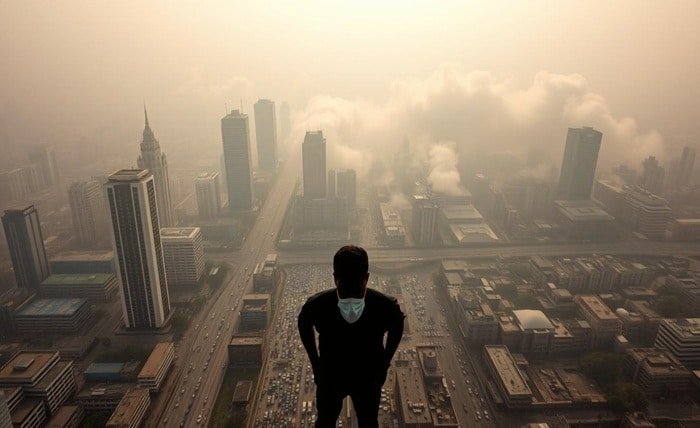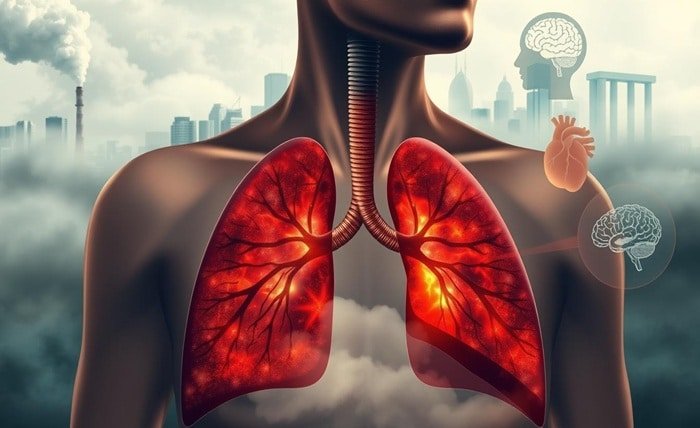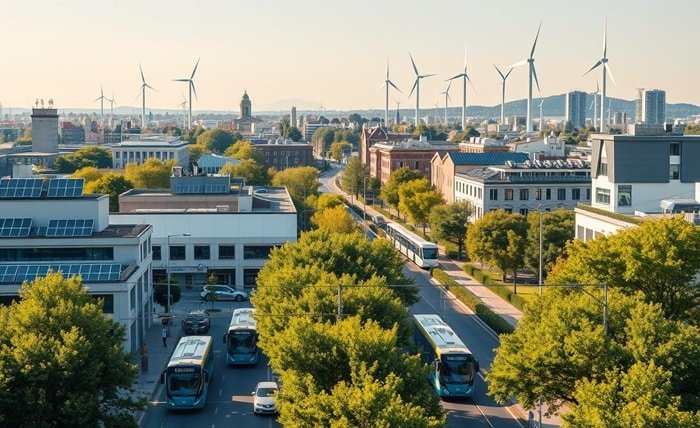भारत में हवा की क्वालिटी खतरनाक स्तर और जरूरी कदम, हवा की क्वालिटी कैसे मापी जाती है? पूरी जानकारी

It’s very important to watch and improve air quality. This affects people’s health and the environment a lot.
भारत में हवा की क्वालिटी की वर्तमान स्थिति
The air quality in India is very bad, affecting health and the environment. Many things are making the air worse.
राष्ट्रीय स्तर पर हवा की गुणवत्ता का अवलोकन
India’s air quality is a big worry. Many people are breathing in harmful air. The levels of tiny particles in the air are higher than what’s safe.
प्रमुख प्रदूषित शहर और क्षेत्र
Many Indian cities have very bad air. Delhi, Varanasi, and Lucknow are among the worst. The main reasons are:
- Vehicular emissions: More cars and trucks are polluting the air.
- Industrial pollution: Factories are also adding to the pollution.
- Construction dust: Building projects are making the air dirtier.
मौसमी प्रभाव और वार्षिक रुझान
Seasons affect the air quality in India. In winter, the air gets worse because it’s colder and the air doesn’t move as much. Burning crops in other states also makes pollution worse at some times.
Every year, keeping the air clean is a big challenge. Some places have worse pollution than others. Knowing this helps us find ways to clean the air.
हवा की क्वालिटी कैसे मापी जाती है?
जानना जरूरी है कि हवा की गुणवत्ता कैसे मापी जाती है। यह जानने से हमें पता चलता है कि हवा में कितने प्रदूषक हैं। इसके लिए कई जटिल प्रक्रियाएं और तकनीकें उपयोग की जाती हैं।
एयर क्वालिटी इंडेक्स (AQI) क्या है?
एयर क्वालिटी इंडेक्स (AQI) एक संख्यात्मक पैमाना है। यह हवा की गुणवत्ता को ‘Good’ से ‘Severe’ तक के विभिन्न स्तरों में वर्गीकृत करता है। यह पैमाना विभिन्न प्रदूषकों के स्तर को देखता है, जैसे कि PM2.5 और PM10, NO2, और O3।
- Good: AQI मान 0-50 के बीच, जो स्वस्थ है।
- Satisfactory: AQI मान 51-100 के बीच, जो संवेदनशील समूहों के लिए थोड़ा जोखिम है।
- Moderate: AQI मान 101-200 के बीच, जो मध्यम जोखिम है।
- Poor: AQI मान 201-300 के बीच, जो संवेदनशील समूहों के लिए बड़ा जोखिम है।
- Very Poor: AQI मान 301-400 के बीच, जो गंभीर जोखिम है।
- Severe: AQI मान 400 से अधिक, जो सभी के लिए बहुत बड़ा जोखिम है।
भारत में उपयोग किए जाने वाले मापन उपकरण
भारत में विभिन्न उपकरणों का उपयोग हवा की गुणवत्ता को मापने के लिए किया जाता है। इनमें शामिल हैं:
- Particulate Matter (PM) monitors
- Gas analyzers for NO2, SO2, and CO
- Ozone monitors
इन उपकरणों का उपयोग हवा में प्रदूषकों के स्तर को सटीक रूप से मापने के लिए किया जाता है।

मॉनिटरिंग स्टेशन और उनका वितरण
शहरों में विभिन्न स्थानों पर मॉनिटरिंग स्टेशन स्थापित किए जाते हैं। ये स्टेशन उन्नत सेंसरों से लैस होते हैं और एक केंद्रीय सर्वर से जुड़े होते हैं।
सेंसर टेक्नोलॉजी और डेटा कलेक्शन
सेंसर प्रौद्योगिकी हवा की गुणवत्ता को निगरानी में महत्वपूर्ण भूमिका निभाती है। आधुनिक सेंसर बहुत सूक्ष्म प्रदूषकों को भी पता लगा सकते हैं। संकलित डेटा का विश्लेषण AQI को निर्धारित करने और भविष्य की हवा की गुणवत्ता की भविष्यवाणी करने के लिए किया जाता है।
प्रमुख वायु प्रदूषक और उनके स्रोत
Understanding major air pollutants is key to better air quality. These pollutants come in different forms and have various sources. We need a detailed plan to lessen their harm.
Particulate Matter (PM2.5 and PM10)
Particulate Matter (PM) is a big air pollutant, split into PM2.5 and PM10 by size. These tiny particles can reach deep into our lungs, causing health issues. Sources include construction, vehicle emissions, and industrial activitis.
Nitrogen Oxides and Sulfur Dioxide
Nitrogen Oxides (NOx) and Sulfur Dioxide (SO2) are harmful gases that pollute the air. NOx mainly comes from vehicles and industries. SO2 is from burning fossil fuels by power plants and cars. Both can cause breathing problems and acid rain.
Carbon Monoxide and Ground-Level Ozone
Carbon Monoxide (CO) is a colorless, odorless gas from incomplete burning, often by vehicles and industries. Ground-Level Ozone (O3) forms when NOx and organic compounds react with sunlight. Both can lead to serious health issues, like breathing problems.
Industrial and Vehicle Emissions
Industrial activities and vehicle emissions are major air pollutant sources. Industrial emissions include many pollutants from manufacturing. Vehicle emissions add to NOx, CO, and PM. Tightening rules on these areas is vital for cleaner air.
We can lessen the effects of these pollutants with policies, technology, and awareness. Important steps include:
- Stricter emission rules for industries and vehicles
- More use of clean energy
- Better public transport and walking/biking paths
- More green spaces to clean the air
Knowing the sources and effects of major air pollutants helps us find ways to reduce them. This way, we can make the air cleaner and healthier.
नीतियों की प्रभावशीलता और चुनौतियां (Effectiveness and Challenges of Policies)
While these policies have shown promise, their effectiveness is often hindered by challenges such as inadequate enforcement and lack of public awareness. A comparative analysis of policy outcomes is presented in the table below:
| Policy/Initiative | Objective | Outcome |
| National Clean Air Program | Reduce PM concentration by 20-30% by 2024 | Partial success in some cities, but overall progress is slow |
| Vehicle Emission Standards (BS VI) | Reduce vehicular emissions | Significant reduction in emissions from new vehicles |

The government must continue to strengthen these policies and ensure their effective implementation to achieve significant improvements in air quality.
हवा की क्वालिटी के खतरनाक स्तर और स्वास्थ्य प्रभाव
भारत में हवा की गुणवत्ता बहुत खराब है। यह देश के लोगों के स्वास्थ्य के लिए खतरनाक है। Air Quality Index (AQI) को समझना और इसके महत्व को समझना बहुत जरूरी है।
विभिन्न AQI श्रेणियों का अर्थ
AQI एक संख्यात्मक माप है जो हवा की प्रदूषण को दिखाता है। यह हवा की गुणवत्ता को कई श्रेणियों में बांटता है।
- Good: AQI value 0-50, minimal health risk
- Satisfactory: AQI value 51-100, minor breathing discomfort for sensitive people
- Moderate: AQI value 101-200, breathing discomfort for people with lung disease
- Poor: AQI value 201-300, breathing discomfort for people on prolonged exposure
- Very Poor: AQI value 301-400, significant breathing discomfort for most people
- Severe: AQI value 401-500, serious health impacts for the entire population
अल्पकालिक स्वास्थ्य प्रभाव
खराब हवा के संपर्क में रहने से कई स्वास्थ्य समस्याएं हो सकती हैं।
- Respiratory problems such as asthma and bronchitis
- Cardiovascular issues like heart attacks and strokes
- Eye, nose, and throat irritation
इन समस्याएं vulnerable populations जैसे बच्चे और बूढ़े लोगों पर अधिक प्रभाव डालती हैं।
दीर्घकालिक स्वास्थ्य जोखिम
लंबे समय तक खराब हवा के संपर्क में रहने से कई गंभीर बीमारियां हो सकती हैं।
- Chronic obstructive pulmonary disease (COPD)
- Lung cancer
- Cardiovascular diseases
प्रदूषित हवा के संपर्क में रहने के साथ-साथ इन बीमारियों का खतरा बढ़ता है।
संवेदनशील जनसंख्या पर प्रभाव
कुछ समूहों को हवा के प्रदूषण के नकारात्मक प्रभावों से अधिक खतरा होता है।
बच्चे और वृद्ध लोगों पर प्रभाव
बच्चे और बूढ़े लोगों को कमजोर प्रतिरक्षा प्रणाली और कम शारीरिक क्षमता के कारण अधिक खतरा होता है।
श्वसन और हृदय रोगियों के लिए जोखिम
श्वसन और हृदय रोगियों को हवा के प्रदूषण के कारण गंभीर स्वास्थ्य समस्याएं हो सकती हैं।
भारत में वायु प्रदूषण के प्रमुख कारण
भारत में वायु प्रदूषण के कारण जानना बहुत जरूरी है। यह देश कई कारणों से प्रदूषित हो रहा है, जिससे यह समस्या बहुत जटिल हो गई है।
औद्योगिक प्रदूषण और थर्मल पावर प्लांट
भारत में औद्योगिक प्रदूषण बहुत बड़ा कारण है। Thermal power plants बहुत सारा particulate matter और गैस जैसे सulfur dioxide और nitrogen oxides छोड़ते हैं। ये प्रदूषक हवा की गुणवत्ता खराब करते हैं और स्वास्थ्य के लिए बहुत हानिकारक होते हैं।
वाहन उत्सर्जन और परिवहन क्षेत्र
परिवहन क्षेत्र, विशेष रूप से वाहनों के उत्सर्जन, भी वायु प्रदूषण का एक बड़ा कारण है। बढ़ती संख्या में वाहनों के कारण carbon monoxide, nitrogen oxides, और particulate matter के उत्सर्जन में वृद्धि हुई है।
कृषि अवशेष जलाना
भारत में कृषि अवशेष जलाना बहुत आम है, खासकर फसल कटाई के समय। यह प्रथा हवा में बहुत सारा particulate matter और विषाक्त गैसें छोड़ती है, जिससे वायु प्रदूषण बढ़ता है।
निर्माण गतिविधियां और धूल
निर्माण गतिविधियां बहुत सारा धूल छोड़ती हैं, जो particulate matter का एक बड़ा हिस्सा है। यह धूल हवा के साथ फैलती है और न केवल निकट क्षेत्रों को प्रभावित करती है, बल्कि दूर के क्षेत्रों में भी इसका प्रभाव पड़ता है।
इन कारणों का समाधान करने के लिए हमें नीति सुधार, तकनीकी उन्नति, और लोगों के व्यवहार में परिवर्तन की आवश्यकता है।
क्षेत्रीय विविधताएं: भारत के विभिन्न हिस्सों में हवा की क्वालिटी
भारत की विविध भौगोलिक और जलवायु स्थितियों के कारण, हवा की गुणवत्ता में क्षेत्रीय अंतर हैं। देश का विशाल क्षेत्रफल विभिन्न प्रकार के पारिस्थितिकी तंत्रों से भरा हुआ है, जिनमें से प्रत्येक के अपने विशिष्ट वायुमंडलीय गुणवत्ता के चुनौतियाँ हैं।
उत्तर भारत और दिल्ली-एनसीआर
उत्तर भारत, विशेष रूप से दिल्ली-एनसीआर क्षेत्र, अपने खराब वायु गुणवत्ता के लिए जाना जाता है। यह क्षेत्र विभिन्न कारणों से गंभीर प्रदूषण का सामना करता है, जैसे कि औद्योगिक गतिविधियों, वाहनों के उत्सर्जन, और खेती के अवशेषों के जलाने के कारण। दिल्ली अक्सर सबसे अधिक प्रदूषित शहरों में से एक होता है। इस क्षेत्र में वायु गुणवत्ता सूचकांक अक्सर सुरक्षित स्तर से परे होता है, जिससे निवासियों के लिए स्वास्थ्य जोखिम बढ़ जाता है।
पश्चिमी और दक्षिणी भारत
पश्चिम और दक्षिण भारत में वायु गुणवत्ता उत्तर भारत की तुलना में बेहतर है। लेकिन, मुंबई और पुणे जैसे शहरों में भी वायु प्रदूषण की समस्या है, जो वाहनों और औद्योगिक गतिविधियों से होती है। तटीय क्षेत्रों में साफ हवा होती है, लेकिन शहरी क्षेत्रों में प्रदूषण का सामना करना पड़ता है।
पूर्वी और पूर्वोत्तर भारत
पूर्व और पूर्वोत्तर भारत में वायु गुणवत्ता के अपने चुनौतीपूर्ण पहलू हैं। औद्योगिक गतिविधियों, खनन, और ईंट किले के जलाने से प्रदूषण होता है। साथ ही, खेती के अवशेषों का जलाना भी वायु गुणवत्ता को खराब करता है। इस क्षेत्र की भौगोलिक संरचना, जिसमें घाटियाँ और पहाड़ियाँ शामिल हैं, प्रदूषकों को फंसाने में मदद करती है, जिससे समस्या और भी बढ़ जाती है।
| Region | Major Sources of Pollution | Notable Features |
| North India (Delhi-NCR) | Industrial activities, vehicular emissions, agricultural burning | Frequently records high AQI levels |
| Western and Southern India | Vehicular emissions, industrial activities | Coastal regions have relatively cleaner air |
| Eastern and Northeastern India | Industrial activities, mining, brick kilns, agricultural burning | Topography traps pollutants, worsening air quality |
सरकारी नीतियां और पहल
To tackle the pressing issue of air pollution, the government has introduced multiple strategies. The Indian government has been proactive in addressing air quality issues through various policies and programs.
राष्ट्रीय स्वच्छ वायु कार्यक्रम (NCAP)
The National Clean Air Programme (NCAP) is a significant initiative aimed at reducing particulate matter concentrations by 20-30% by 2024, relative to 2017 levels. NCAP focuses on implementing short-term and long-term measures to improve air quality across the country.
ग्रेडेड रेस्पांस एक्शन प्लान (GRAP)
The Graded Response Action Plan (GRAP) is another key policy in the National Capital Region (NCR) to tackle air pollution. GRAP outlines specific actions to be taken based on the Air Quality Index (AQI), ranging from “Poor” to “Severe” categories.
वाहन उत्सर्जन मानक और ईंधन नीतियां
India has been adopting stricter vehicle emission standards, such as BS-VI norms, to reduce vehicular pollution. The government has also promoted the use of cleaner fuels like Compressed Natural Gas (CNG) and Liquefied Petroleum Gas (LPG).
अंतर्राष्ट्रीय सहयोग और प्रतिबद्धताएं
India is actively participating in international forums to address air pollution. The country has collaborated with other nations to share best practices and technologies to improve air quality.
- NCAP aims to reduce particulate matter concentrations.
- GRAP implements actions based on AQI levels.
- Stricter emission norms are being adopted.
- Cleaner fuels are being promoted.
हवा की क्वालिटी में सुधार के लिए जरूरी कदम
भारत में हवा की गुणवत्ता में सुधार के लिए कई कदम उठाने होंगे। इसमें कई संगठनों और रणनीतियों का सहयोग आवश्यक है।
सार्वजनिक परिवहन और इलेक्ट्रिक वाहनों को बढ़ावा
हवा प्रदूषण कम करने के लिए सार्वजनिक परिवहन और इलेक्ट्रिक वाहनों का उपयोग बढ़ाना महत्वपूर्ण है। इससे सड़कों पर निजी वाहनों की संख्या कम होगी, जिससे वायु प्रदूषण कम होगा।
शहरों में सार्वजनिक परिवहन को बेहतर बनाने और इलेक्ट्रिक वाहनों के उपयोग को बढ़ावा देने के लिए निवेश करना चाहिए। इलेक्ट्रिक वाहनों के लिए सब्सिडी देने और चार्जिंग स्टेशनों का विस्तार करना भी महत्वपूर्ण है।
स्वच्छ ऊर्जा स्रोतों का विस्तार
स्वच्छ ऊर्जा स्रोतों का उपयोग बढ़ाना भी हवा की गुणवत्ता में सुधार के लिए आवश्यक है। यह फॉसिल फ्यूल्स से दूरी बनाने के लिए सौर और वायुमंडलीय ऊर्जा का उपयोग करने के बारे है।
भारत ने स्वच्छ ऊर्जा में महत्वपूर्ण प्रगति की है। इस क्षेत्र में और अधिक निवेश करने से प्रदूषणकारी बिजली गृहों पर निर्भरता कम होगी।
कृषि प्रथाओं में सुधार
कृषि प्रथाओं में सुधार भी महत्वपूर्ण है। खासकर, फसल अवशेषों को जलाने से हवा प्रदूषित होती है। कृषि प्रथाओं में सुधार के लिए फसलों के चक्र में बदलाव, अवशेषों के प्रबंधन में नए तरीके, और मशीनीकृत खेती को बढ़ावा देना आवश्यक है।
शहरी वनीकरण और हरित क्षेत्र
शहरी वनीकरण और हरित क्षेत्र हवा की गुणवत्ता में सुधार में महत्वपूर्ण भूमिका निभाते हैं। वे प्रदूषकों को अवशोषित करते हैं और ऑक्सीजन उत्पन्न करते हैं। शहरों के योजना बनाने में हरित क्षेत्रों को बनाए रखना और पार्क, हरित छतें, और शहरी वनों का विकास महत्वपूर्ण है।
अंतरराष्ट्रीय सफल मॉडल और केस स्टडीज
विश्वभर में कई शहर हवा की गुणवत्ता में सुधार के लिए सफल हुए हैं। लंदन का कंजेशन चार्ज वाहनों की संख्या और प्रदूषण को कम करने में मददगार साबित हुआ है। सिंगापुर और टोक्यो जैसे शहरों ने व्यापक सार्वजनिक परिवहन और हरित पहलों को अपनाया है।
इन अंतरराष्ट्रीय मॉडलों का अध्ययन भारतीय शहरों को अपनी हवा की गुणवत्ता में सुधार करने में मदद कर सकता है।
व्यक्तिगत स्तर पर वायु प्रदूषण से बचाव के उपाय
भारत में वायु गुणवत्ता खराब हो रही है। इस समस्या का समाधान खोजने के लिए, हमें व्यक्तिगत कदम उठाने होंगे। व्यक्तिगत सुरक्षा के लिए कुछ प्रभावी तरीके अपनाने से हमें वायु प्रदूषण के दुष्प्रभावों से बचने में मदद मिल सकती है।
एयर प्यूरिफायर और मास्क का उपयोग
एयर प्यूरिफायर का उपयोग करके हम घर के अंदर की वायु गुणवत्ता में सुधार कर सकते हैं। ये उपकरण वायु में मौजूद कण और अन्य प्रदूषकों को कम कर सकते हैं। बाहर निकलने पर मास्क पहनने से भी हम वायु प्रदूषण से बच सकते हैं, खासकर जब वायु गुणवत्ता खराब हो।
घर के अंदर वायु गुणवत्ता में सुधार
घर के अंदर वायु गुणवत्ता सुधारना बहुत जरूरी है। इसके लिए, अच्छी हवा के प्रवाह को सुनिश्चित करना, एयर प्यूरिफायर का उपयोग करना, और प्रदूषक उत्पन्न करने वाली गतिविधियों से बचना महत्वपूर्ण है। जैसे कि धूम्रपान या कुछ प्रकार के खाने पकाने के ईंधन का उपयोग करने से बचना चाहिए।
प्रदूषण के उच्च स्तर के दौरान सावधानियां
जब वायु गुणवत्ता बहुत खराब हो, तो बच्चे, बूढ़े लोग, और स्वास्थ्य संबंधी समस्याओं वाले लोगों को बाहर निकलने से बचना चाहिए। घर के दरवाजे और खिड़कियों को बंद रखने से भी वायु प्रदूषण को घर में प्रवेश करने से रोका जा सकता है।
जागरूकता और सामुदायिक भागीदारी
सामुदायिक भागीदारी और जागरूकता वायु प्रदूषण का समाधान करने के लिए महत्वपूर्ण हैं। हम सभी अपने समुदाय में भाग ले सकते हैं, जागरूकता फैला सकते हैं, और स्वच्छता और नीतियों के लिए प्रयास कर सकते हैं।
इन कदमों से हम वायु प्रदूषण के प्रति कम संवेदनशील हो सकते हैं। हमें स्वच्छ वायु की ओर एक बड़ा कदम बढ़ाने में मदद मिल सकती है।
निष्कर्ष: स्वच्छ हवा की ओर भारत का सफर
भारत में हवा की गुणवत्ता बहुत खराब है। इस समस्या का समाधान केवल एक ही तरीके से हो सकता है – सामूहिक प्रयास। सरकार, उद्योग और व्यक्ति सभी को मिलकर काम करना होगा।
सरकार की पहलें जैसे राष्ट्रीय स्वच्छ वायु कार्यक्रम बहुत महत्वपूर्ण हैं। ग्रेडेड रेस्पांस एक्शन प्लान भी वायु गुणवत्ता में सुधार के लिए कदम हैं।
भारत स्वच्छ हवा की ओर बढ़ने के लिए कई कदम उठा सकता है। सार्वजनिक परिवहन को बढ़ावा देना और स्वच्छ ऊर्जा का उपयोग करना आवश्यक है। कृषि में भी सुधार की जरूरत है।
व्यक्तिगत स्तर पर भी, हमें एयर प्यूरिफायर और मास्क का उपयोग करना चाहिए। घर के अंदर वायु गुणवत्ता में सुधार करना भी जरूरी है। प्रदूषण के समय सावधानी बरतना भी आवश्यक है।
स्वच्छ हवा की यात्रा एक लंबी और मुश्किल प्रक्रिया है। लेकिन, सभी की सहयोग और प्रतिबद्धता से यह संभव है। Clean Air के लिए हमें इस यात्रा को जारी रखना होगा।

FAQ
What is the Air Quality Index (AQI) and how is it used in India?
The Air Quality Index (AQI) shows how clean the air is. In India, it helps sort air quality into levels. These levels range from ‘Good’ to ‘Severe’, based on pollutants like PM2.5 and PM10.
What are the main sources of air pollution in India?
Air pollution in India comes from many sources. These include industrial emissions, car exhaust, and burning agricultural waste. Also, construction and dust from roads add to the problem.
How does air pollution affect health in India?
Air pollution can lead to many health issues. These range from mild breathing problems to serious diseases like heart disease and lung cancer. Children, the elderly, and those with health issues are most at risk.
What is being done by the government to improve air quality in India?
The Indian government is taking action. They have the National Clean Air Programme (NCAP) and the Graded Response Action Plan (GRAP). They also have stricter rules for vehicle emissions.
What can individuals do to protect themselves from air pollution?
There are steps people can take. Using air purifiers and wearing masks when pollution is high helps. Keeping indoor air clean and staying updated on AQI are also important.
How can air quality be improved in urban areas?
Urban areas can improve air quality in several ways. Promoting public transport and electric vehicles is one step. Expanding clean energy and green spaces also helps. Stricter pollution controls are needed too.
What role does agricultural residue burning play in air pollution?
Burning agricultural waste is a big problem in North India. It releases harmful particles into the air. This worsens air quality and causes haze.
Are there any international collaborations aimed at improving air quality in India?
Yes, India works with other countries and organizations. They share knowledge and technologies to clean the air. This is part of a global effort to fight air pollution.





